key Citroen NEMO 2015 1.G Owner's Guide
[x] Cancel search | Manufacturer: CITROEN, Model Year: 2015, Model line: NEMO, Model: Citroen NEMO 2015 1.GPages: 192, PDF Size: 7.84 MB
Page 65 of 192
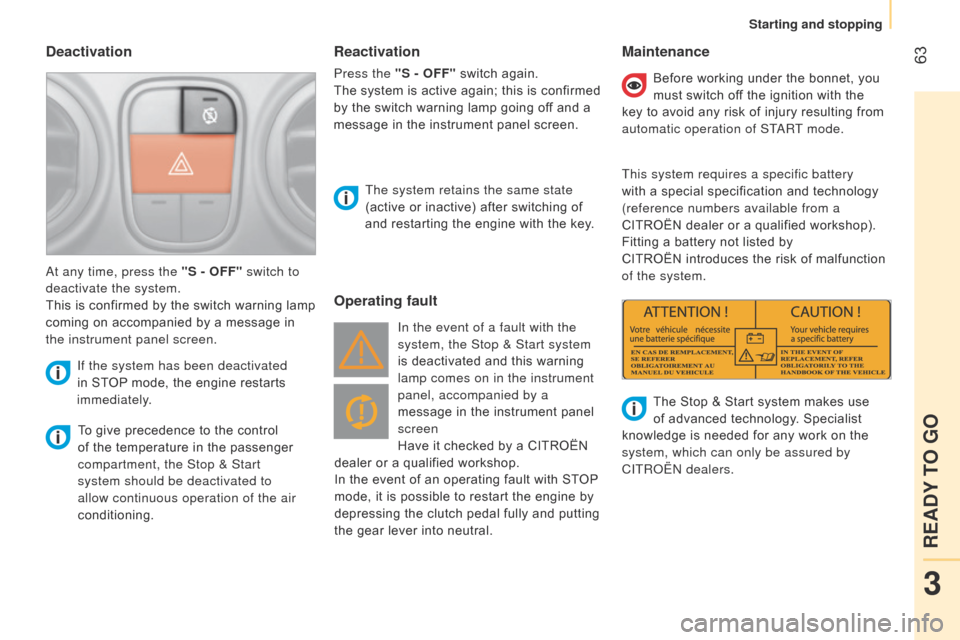
63Deactivation
To give precedence to the control
of the temperature in the passenger
compartment, the Stop & Start
system should be deactivated to
allow continuous operation of the air
conditioning.The system retains the same state
(active or inactive) after switching of
and restarting the engine with the key.
a
t any time, press the "S - OFF" switch to
deactivate the system.
This is confirmed by the switch warning lamp
coming on accompanied by a message in
the instrument panel screen.
If the system has been deactivated
in STOP mode, the engine restarts
immediately.
Operating fault Maintenance
In the event of a fault with the
system, the Stop & Start system
is deactivated and this warning
lamp comes on in the instrument
panel, accompanied by a
message in the instrument panel
screen
Have it checked by a CITROËN
dealer or a qualified workshop.
In the event of an operating fault with STOP
mode, it is possible to restart the engine by
depressing the clutch pedal fully and putting
the gear lever into neutral. Before working under the bonnet, you
must switch off the ignition with the
key to avoid any risk of injury resulting from
automatic operation of ST
a
RT mode.
This system requires a specific battery
with a special specification and technology
(reference numbers available from a
CITROËN dealer or a qualified workshop).
Fitting a battery not listed by
CITROËN introduces the risk of malfunction
of the system.
The Stop & Start system makes use
of advanced technology. Specialist
knowledge is needed for any work on the
system, which can only be assured by
CITR
o Ë n dealers.
Reactivation
Press the "S - OFF" switch again.
The system is active again; this is confirmed
by the switch warning lamp going off and a
message in the instrument panel screen.
3
READY TO GO
Starting and stopping
Page 93 of 192
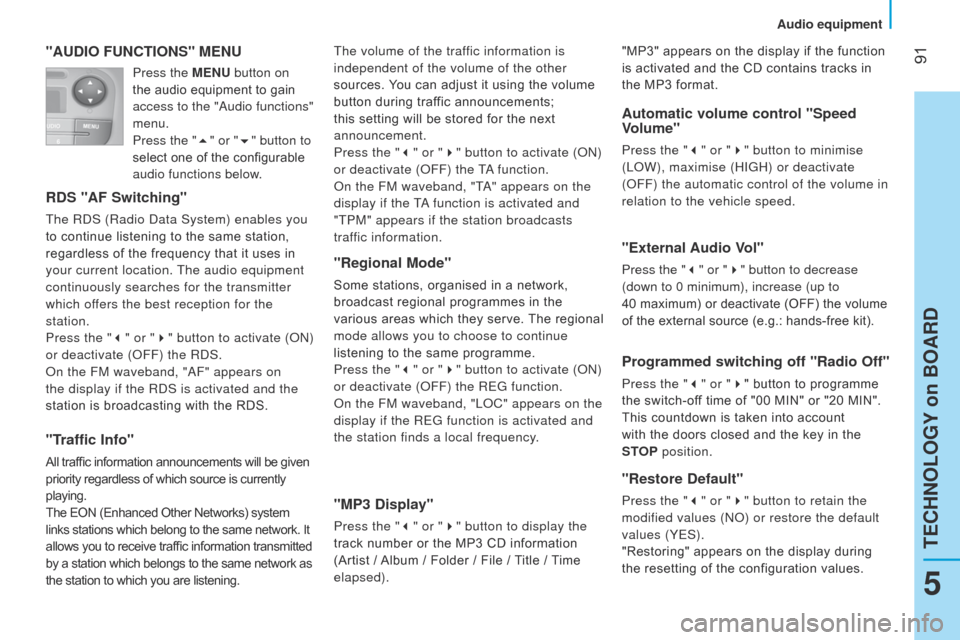
91"AUDIO FUNCTIONS" MENU
RDS "AF Switching"
The RdS (Radio data System) enables you
to continue listening to the same station,
regardless of the frequency that it uses in
your current location. The audio equipment
continuously searches for the transmitter
which offers the best reception for the
station.
Press the "3 " or "4" button to activate (
on )
or deactivate (
o FF) the R d S.
o
n the FM waveband, " a F" appears on
the display if the R
d S is activated and the
station is broadcasting with the RDS.
"Traffic Info"
All traffic information announcements will be given
priority regardless of which source is currently
playing.
The EON (Enhanced Other Networks) system
links stations which belong to the same network. It
allows you to receive traffic information transmitted
by a station which belongs to the same network as
the station to which you are listening.
"Regional Mode"
Some stations, organised in a network,
broadcast regional programmes in the
various areas which they serve. The regional
mode allows you to choose to continue
listening to the same programme.
Press the "3 " or "4" button to activate (
on )
or deactivate (
o FF) the REG function.
o
n the FM waveband, "L o C" appears on the
display if the REG function is activated and
the station finds a local frequency.
"MP3 Display"
Press the "3 " or "4" button to display the
track number or the MP3 CD information
(Artist / Album / Folder / File / Title / Time
elapsed).
Automatic volume control "Speed
Volume"
Press the "3 " or "4" button to minimise
(L o W), maximise (HIGH) or deactivate
(
o FF) the automatic control of the volume in
relation to the vehicle speed.
The volume of the traffic information is
independent of the volume of the other
sources. You can adjust it using the volume
button during traffic announcements;
this setting will be stored for the next
announcement.
Press the "3
" or "4" button to activate (
on
)
or deactivate (
o
FF) the T
a function.
o
n the FM waveband, "T
a
" appears on the
display if the T
a function is activated and
"TPM" appears if the station broadcasts
traffic information.
"External Audio Vol"
Press the "3 " or "4" button to decrease
(down to 0 minimum), increase (up to
40
maximum) or deactivate (OFF) the volume
of the external source (e.g.: hands-free kit).
Programmed switching off "Radio Off"
Press the "3 " or "4" button to programme
the switch-off time of "00 MIN" or "20 MIN".
This countdown is taken into account
with the doors closed and the key in the
STOP
position.
"Restore Default"
Press the "3 " or "4" button to retain the
modified values ( no ) or restore the default
values (YES).
"Restoring" appears on the display during
the resetting of the configuration values. "MP3" appears on the display if the function
is activated and the CD contains tracks in
the MP3 format.
Press the MENU
button on
the audio equipment to gain
access to the "
a
udio functions"
menu.
Press the "5 " or "6" button to
select one of the configurable
audio functions below.
5
TECHNOLOGY on BOARD
Audio equipment
Page 102 of 192

100
Transferring an active call
There are 2 options:
1 -
From the mobile telephone to the hands-
free system
With the ignition on, the recognition
connection between the mobile telephone
and the vehicle's audio equipment is done
automatically.
Confirm this recognition using the keypad on
the mobile telephone.
The call can then be transferred.
Placing a call on hold Call list
This enables you to call the number of one
of the last 10 calls received, of one of the
last 10 people called or of one of the last 5
missed calls.
2 -
From the hands-free system to the
mobile telephone
Press to deactivate the
microphone and place your
contact on hold.
Press again to resume the
conversation.
a
ctivate the main menu.
Select C
a LL LIST.
Confirm.
Select the number to be called.
Confirm. "Callback" for the last person who
called you, or
"Redial" for the last person you
called.
"Yes" or "No" to confirm/cancel.
The "Redial" button can also be
used.
The system will again ask "Redial or
callback?".
"Callback" to call back the last
person who called you.
"Redial" to redial the last person you
called.
Press, the system's controls are
still active.
Bluetooth hands-free system
Page 103 of 192
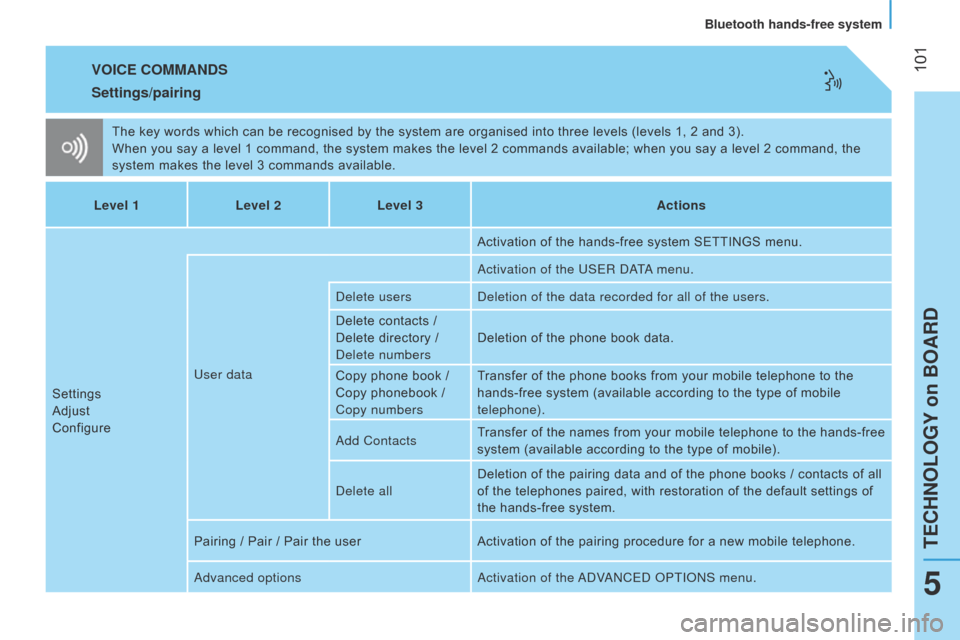
101VOICE COMMANDS
The key words which can be recognised by the system are organised into three levels (levels 1, 2 and 3).
When you say a level 1 command, the system makes the level 2 commands available; when you say a level 2 command, the
system makes the level 3 commands available.
Settings/pairing
Level 1Level 2Level 3 Actions
Settings
Adjust
Configure User data Activation of the hands-free system SETTINGS menu.
a
ctivation of the USER da
Ta menu.
d
elete users
d
eletion of the data recorded for all of the users.
Delete contacts /
Delete directory /
d
elete numbersDeletion of the phone book data.
Copy phone book /
Copy phonebook /
Copy numbers Transfer of the phone books from your mobile telephone to the
hands-free system (available according to the type of mobile
telephone).
a
dd ContactsTransfer of the names from your mobile telephone to the hands-free
system (available according to the type of mobile).
d
elete allDeletion of the pairing data and of the phone books / contacts of all
of the telephones paired, with restoration of the default settings of
the hands-free system.
Pairing / Pair / Pair the user Activation of the pairing procedure for a new mobile telephone.
a
dvanced options
a
ctivation of the
ad
V
an
CE d o PTI on S menu.
TECHNOLOGY on BOARD
Bluetooth hands-free system
5
Page 104 of 192

102
The key words which can be recognised by the system are organised into three levels (levels 1, 2 and 3).
When you say a level 1 command, the system makes the level 2 commands available; when you say a level 2 command, the
system makes the level 3 commands available.
VOICE COMMANDS
Mobile
telephone with hands-free function
Level 1 Level 2Level 3 Actions
Dial / Dial a number
o
ne, Two, ... , Plus,
Star, Hash
Call / DialEntering the digits or symbols to dial the telephone number.
Delete / Correct Deletion of the last group of digits entered.
Start over Deletion of all of the groups of digits entered with the option of
entering a new number.
Repeat Repeating the telephone number entered and recognised by the
hands-free system.
Cancel Cancellation of dialling of the number.
Sending the call to the number entered verbally.
Call [
n ame] Yes / No
Call to the name of the person, stored in the system's phone book.
Mobile Call to the name of the person with personalisation if there are
several numbers stored in the system.
Home
Work / Office
Redial Call to the last person called.
Callback Call to the last person who called.
Bluetooth hands-free system
Page 107 of 192

105VOICE COMMANDS
Message reader
The key words which can be recognised by the system are organised into three levels (levels 1, 2 and 3).
When you say a level 1 command, the system makes the level 2 commands available; when you say a level 2 command, the
system makes the level 3 commands available.
Level 1 Level 2Level 3 Actions
Message reader
Messages Messages received /
Received
a
ctivation of the MESS. RE ad ER menu.
Activation of the list of text messages received.
Read/ read again Reads the text message selected in the list.
Call Deletion of the phone book data.
d
eleteTransfer of the phone books from your mobile telephone to the
hands-free system (available according to the type of mobile).
Back / Next / Next Go to the next text message in the list.
Back / PREVIOUS Go to the previous test message in the list.
Read last / read last message / read message Read the last text message received.
Delete all / Delete messages / Delete Delete all text messages in the list after confirmation.
TECHNOLOGY on BOARD
Bluetooth hands-free system
5
Page 111 of 192

109VOICE COMMANDS
Portable audio
device
Level 1 Actions
Player / Multimedia player / Media player
a
ctivation of the ME d I a
PL
a
YER menu.
Play / Play the track / Play the multimedia file
a
ctivation of play.
Stop / Stop the track / Stop the multimedia file Interruption of playing of the current file.
Next / Next track Go to the next menu or file.
PREVIOUS / Previous track / Back Go to the previous menu or file.
Shuffle on / Random play on Activation of playing of the files in random order.
Shuffle off / Random play off Deactivation of playing of the files in random order.
Track repeat on / Repeat on / Repeat Activation of playing of the files in a loop.
Track repeat off / Repeat off Deactivation of playing of the files in a loop.
Now playing / Track information / What is playing / What is this? Display of the information for the file currently being played.
USB media settings / USB settings
a
ctivation of the ME d I a
PL
a
YER menu.
a
ctivate automatic play
a
ctivation of automatic play on connection of a portable device.
d
eactivate automatic play
d
eactivation of automatic play on connection of a portable device.
Shuffle / Any / Random Activation of play of all tracks in random order
The key words which can be recognised by the system are organised into three levels (levels 1, 2 and 3).
When you say a level 1 command, the system makes the level 2 commands available; when you say a level 2 command, the
system makes the level 3 commands available.
TECHNOLOGY on BOARD
Bluetooth hands-free system
5
Page 120 of 192

11 8
FRONT SEAT BELTS
The front seats are fitted with pre-tensioners
and force limiters.
Fastening
Pull the strap, then insert the tongue into the
buckle.
Check that the seat belt is fastened correctly
by pulling the strap.
The lap belt must be positioned as low as
possible on the pelvis. The chest belt must
pass over the hollow of the shoulder.
Inertia reel seat belts
These are fitted with a device which locks
automatically in the event of a collision or
emergency braking.
Safety in the event of a front impact has
been improved by the introduction of
pretensioning and force limiting seat belts.
Depending on the seriousness of the
impact, the pretensioning system instantly
tightens the seat belt against the body of the
occupant.
The pretensioning seat belts are active when
the ignition is on.
The force limiter reduces the pressure of the
seat belt against the body of the occupant in
the event of an accident.
Driver's seat belt not fastened warning
lamp
When the vehicle is started, this
warning lamp comes on if the
driver has not fastened their seat
belt.
REAR SEAT BELTS (COMBI)
The 3-seat bench is fitted with three-point
inertia reel seat belts with force limiter.
The centre seat has a seat belt guide and
inertia reel, integrated with the seat back.
When a seat belt is not in use, you can
store its buckle in the housing provided
in the bench seat cushion.
If the driver's seat belt is unfastened,
the ST
a
RT mode of Stop & Start will
not be invoked. The engine can only be
restarted using the ignition key.
Seat belts
Page 135 of 192
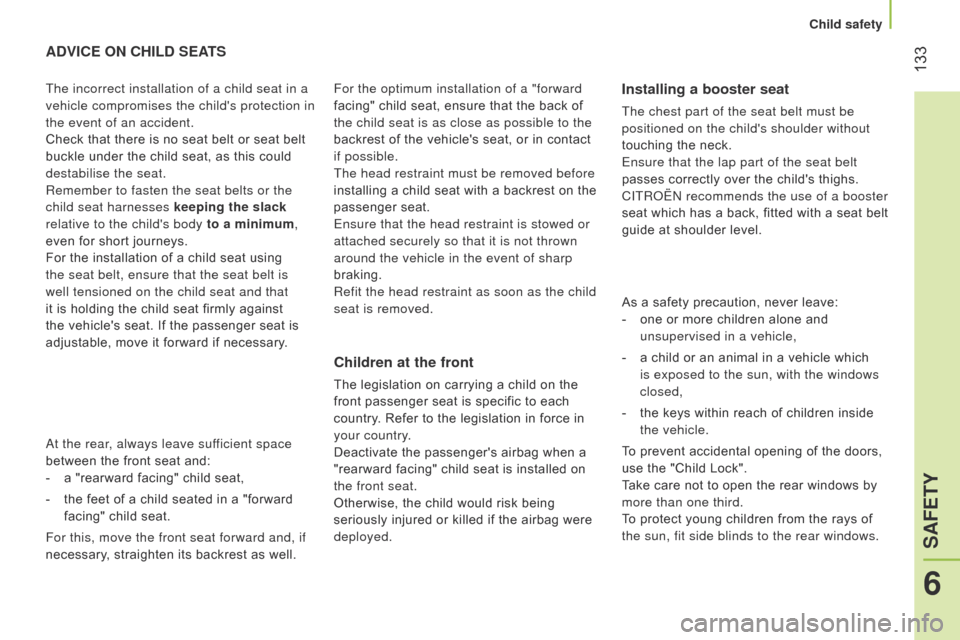
133
ADVICE ON CHILD SEATS
Children
at the front
The legislation on carrying a child on the
front passenger seat is specific to each
country. Refer to the legislation in force in
your country.
Deactivate the passenger's airbag when a
"rearward facing" child seat is installed on
the front seat.
Otherwise, the child would risk being
seriously injured or killed if the airbag were
deployed.
The incorrect installation of a child seat in a
vehicle compromises the child's protection in
the event of an accident.
Check that there is no seat belt or seat belt
buckle under the child seat, as this could
destabilise the seat.
Remember to fasten the seat belts or the
child seat harnesses keeping the slack
relative to the child's body to a minimum,
even for short journeys.
For the installation of a child seat using
the seat belt, ensure that the seat belt is
well tensioned on the child seat and that
it is holding the child seat firmly against
the vehicle's seat. If the passenger seat is
adjustable, move it forward if necessary.
Installing a booster seat
The chest part of the seat belt must be
positioned on the child's shoulder without
touching the neck.
Ensure that the lap part of the seat belt
passes correctly over the child's thighs.
CITR
o Ë n recommends the use of a booster
seat which has a back, fitted with a seat belt
guide at shoulder level.
For the optimum installation of a "forward
facing" child seat, ensure that the back of
the child seat is as close as possible to the
backrest of the vehicle's seat, or in contact
if possible.
The head restraint must be removed before
installing a child seat with a backrest on the
passenger seat.
Ensure that the head restraint is stowed or
attached securely so that it is not thrown
around the vehicle in the event of sharp
braking.
Refit the head restraint as soon as the child
seat is removed.
As a safety precaution, never leave:
-
one or more children alone and
unsupervised in a vehicle,
-
a child or an animal in a vehicle which
is exposed to the sun, with the windows
closed,
-
the keys within reach of children inside
the vehicle.
To prevent accidental opening of the doors,
use the "Child Lock".
Take care not to open the rear windows by
more than one third.
To protect young children from the rays of
the sun, fit side blinds to the rear windows.
a
t the rear, always leave sufficient space
between the front seat and:
-
a "rearward facing" child seat,
-
the feet of a child seated in a "forward
facing" child seat.
For this, move the front seat forward and, if
necessary, straighten its backrest as well.
6
SAFETY
Child safety
Page 144 of 192
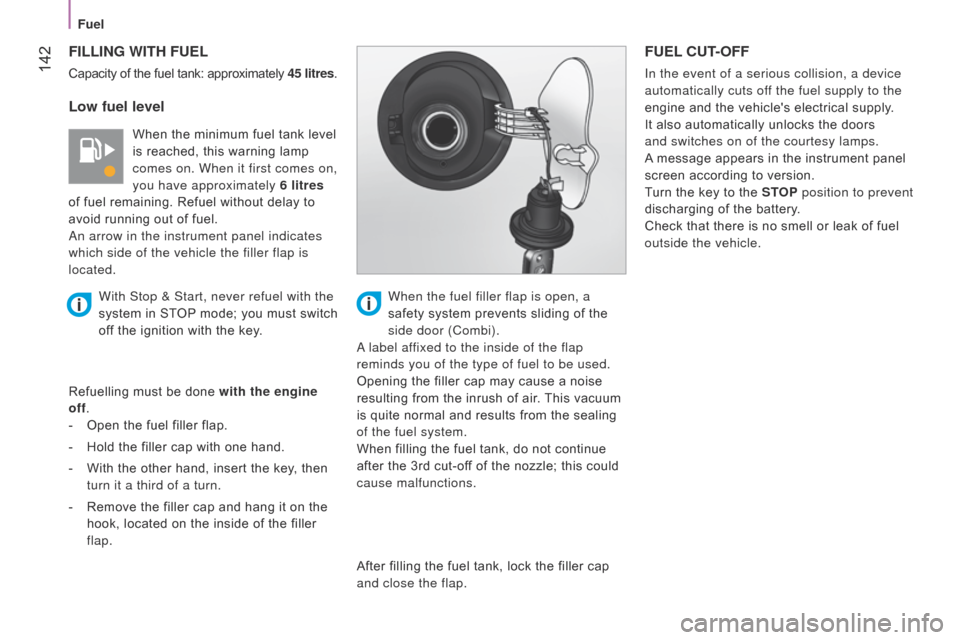
142
FILLING WITH FUEL
Capacity of the fuel tank: approximately 45 litres.
Low fuel level
When the minimum fuel tank level
is reached, this warning lamp
comes on. When it first comes on,
you have approximately 6 litres
of fuel remaining. Refuel without delay to
avoid running out of fuel.
a
n arrow in the instrument panel indicates
which side of the vehicle the filler flap is
located.
Refuelling must be done with the engine
off.
-
Open the fuel filler flap.
-
Hold the filler cap with one hand.
-
With the other hand, insert the key
, then
turn it a third of a turn.
-
Remove the filler cap and hang it on the
hook, located on the inside of the filler
flap.
FUEL CUT-OFF
In the event of a serious collision, a device
automatically cuts off the fuel supply to the
engine and the vehicle's electrical supply.
It also automatically unlocks the doors
and switches on of the courtesy lamps.
A
message appears in the instrument panel
screen according to version.
Turn the key to the STOP position to prevent
discharging of the battery.
Check that there is no smell or leak of fuel
outside the vehicle.
With Stop & Start, never refuel with the
system in STOP mode; you must switch
off the ignition with the key. When the fuel filler flap is open, a
safety system prevents sliding of the
side door (Combi).
a label af
fixed to the inside of the flap
reminds you of the type of fuel to be used.
Opening the filler cap may cause a noise
resulting from the inrush of air. This vacuum
is quite normal and results from the sealing
of the fuel system.
When filling the fuel tank, do not continue
after the 3rd cut-off of the nozzle; this could
cause malfunctions.
After filling the fuel tank, lock the filler cap
and close the flap.
Fuel